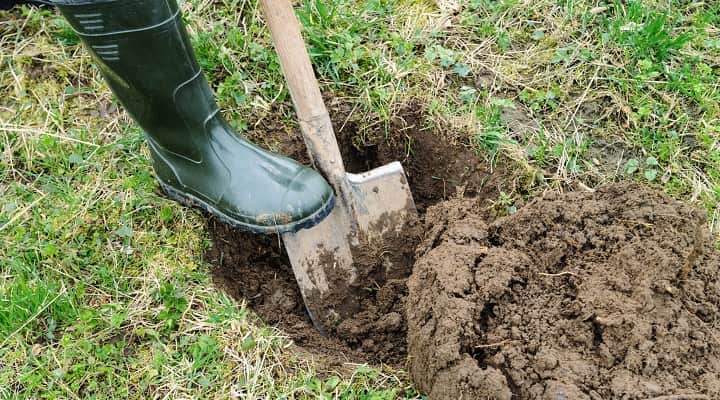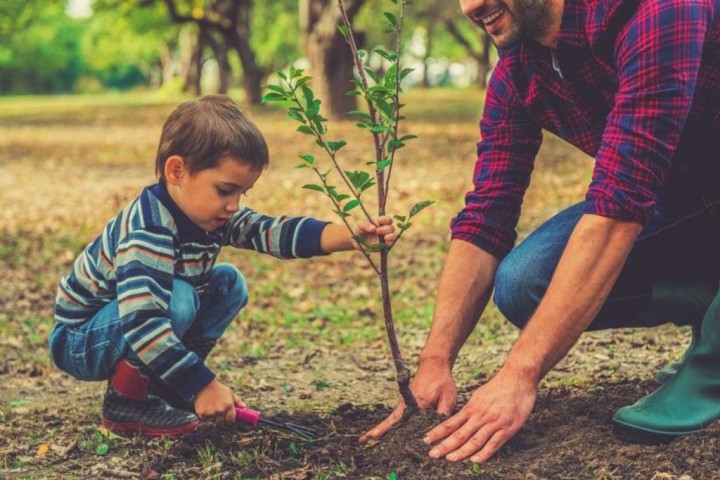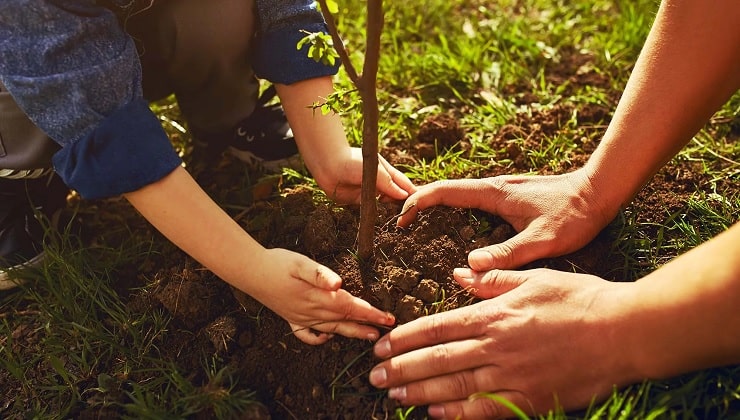Did you know that planting a tree and taking care of it is one of the ways to improve mood and mental health? Human nature was created to give life, so taking care of plants, pets, or work related to building a career makes us feel good. Autumn and late winter is the time for tree planting. This article explains what you need to know about tree planting. After reading this article, you will learn which spaces are suitable for tree planting, how to place the sapling in the soil, and how to take care of it to become a solid and fruitful tree. You will also learn the differences between planting fruit trees and ornamental trees. Stay with us.
How to plant a tree?
To plant a tree, you must first find a suitable place and ensure that your tiny seedling is far away from buildings or other trees. Then you must dig a hole with the appropriate dimensions and place the seedling inside. In the following, we explain how to plant a tree step by step and what points to pay attention to during planting.
1. Choosing the right seedling
The tree you choose should be compatible with the climate where you live. For example, a palm tree dies and does not bear fruit in humid areas. This tree should be planted in dry and desert areas. When the seedling is adapted to the climate and soil of the site, it needs less fertilizer and grows even in unamended soil.
2. Choosing the right time and place
Late winter or autumn is the best time to plant a tree because the roots of the trees are dormant and will not be shocked by being moved. Of course, tiny seedlings can still not withstand much cold and will die, so it is wrong to plant a tree on frigid days. Tree roots are fully active in late spring and summer; Moving during these times shocks the tree and endangers its life.
The best time to plant a tree is before the first frost in autumn or after the last ice in winter.
3. Irrigation of the soil before planting trees
From then on, the primary process begins, and you must learn how to plant a tree. First, water the space where you will dig the hole nicely. Irrigation before planting will moisten the soil and make digging easier. Also, the wet soil embraces the root of the newly transplanted seedling entirely and minimizes the shock of moving.
4. digging a hole
The dimensions of the hole you dig should be 2 to 3 times the size of the seedling’s root so that the roots can easily fit in the hole and not be disturbed. When you excavate to dig a hole, put the soil next to the spot because you will need it later to fill it and put dirt over the roots. Shoveling and digging will be easier if you have moistened the ground beforehand.

Ensure the hole is deep enough and all parts of the seedling’s roots are in the soil. The beginning of the tree trunk should be level with the ground, and the seeds should be entirely inside the pit. If the hole is too bottomless, oxygen will not reach the roots, and the tree will die. Also, water may collect in the spot and cause rotting of the roots and the lower part of the tree trunk.
5. Putting the seedling in the pit
Remove the loose soil from the pit’s wall and place the tree inside. The roots of the tree must be placed on solid ground. Once the tree is firmly in place, make sure that the point where the tree trunk connects to the roots is resting on the soil. This point is also called root flare. If the hearts of the seedling are wrapped in a bag, so they are not damaged during transport, you should remove this bag before placing the seedling in the pit so that the roots are free.
6. Filling the pit after planting a tree
If the soil you dug out of the pit has lumps, hit it with a shovel to pulverize it. Then fill the hole and gently hit the raised parts with a shovel until the soil is smooth and uniform. You can do this by hand. Be careful not to compact the soil too much, as it will no longer be porous, and oxygen will not reach the plant’s roots. Remember that the earth should not be mixed with fertilizers or other substances. Direct use of fertilizer next to plant roots rots them.
After filling the pit, it is time to rinse. Slowly pour some water on the pit’s surface; High-pressure watering washes away or compacts the soil. Continue watering until the ground at the tree’s base is saturated. High humidity causes the soil around the roots to settle, and the tree fits more easily in its new home.
7. Tree care
A few days after planting the tree, put mulch or soil on the surface around the trunk. If you go to the forest, you will notice that the top surface of the earth is covered with materials such as dry leaves, pieces of wood, or tree bark; This cover is called “mulch.” You should also apply mulch to maintain soil moisture, prevent weed growth, and regulate temperature. Make sure that a small circle with a diameter of 10 cm around the tree trunk remains empty and without mulch so that it does not rot.
Watering the tree in the first two years
The first two years are the most critical period after tree planting. At this time, the soil should always be moist; the watering frequency depends on the weather and soil type of your area. In humid regions, trees need less water, but in desert areas, they need more water. Excessive watering is as harmful to trees as underwatering; Make sure that water does not accumulate in the pit at the foot of the tree and does not remain for a long time.
When the ground is frozen or covered with snow in winter, you do not need to water the tree.
The difference between the method of planting fruit trees and ordinary trees
The correct method of producing a fruit tree differs significantly from other trees. Of course, some trees should be planted uniquely. In the following, we point out the differences between planting fruit trees and planting other trees:
- Dig a bowl-shaped hole for the fruit tree instead of a cylinder.
- If the seedling is transplanted, the transplanted part should not be placed inside the soil and should be level with the ground.
- If the tree is single-jointed, the direction of the joint should be toward the north. But if you have used several links to plant seedlings, the minor link should be towards the south.
- You can also plant dwarf fruit trees in pots. Of course, trees planted in pots need more fertilizer, mulch, and nutrients because their roots do not branch, and their soil is limited.
To plant a fruit tree, you must pay attention to the type of tree and essential points about its planting. For example, to produce a walnut tree, you should choose a land with soft soil whose pH is 6 to 6.5.

Some fruit trees can be planted in different ways. For example, it is possible to produce an apple tree in the following six courses:
- planting seeds;
- Cutting
- planting seedlings;
- Pajoosh
- put to sleep
- link.
Professional gardeners can use all these methods, but if you have no experience in gardening and agriculture, it is better to buy a ready-made seedling for planting an apple tree and planting it in the soil, as we explained in the previous sections.
Is it possible to plant a tree on the rocky ground?
Planting trees on rocky ground requires a lot of skill and care. The tiny seedlings have just come to life and must try to adapt to the environment and survive! Being placed in a rocky climate is an ax to their weak and fresh roots and increases the possibility of their death. On the other hand, the origins of trees in stony lands do not have enough access to the soil and cannot provide the nutrients the tree needs. The stones also do not allow the roots to branch. As a result, the tree faces a lack of resources and is damaged.
Even when digging a hole, if you see a stone in the soil, you should remove it and ensure the plant’s roots lie on the soft soil bed.
Additional tips about the correct method of tree planting
Up to this part of the article, the answer to the question “How to plant a tree?” got the Now we will explain three additional points, following which the probability of survival and growth of the tree increases.
- Start pruning from the second year onwards. In winter, cut the extra and diseased branches with sharp scissors.
- Do not over-enrich the soil with fertilizers and nutrients because the roots of the plant will not branch and get used to receiving nutrients in the pit.
- Make sure that the tree remains flat after filling the hole. If the seedling’s trunk is weak, place an auxiliary stick next to it. The height of the wood should be at least one-third of the size of the seedling itself.
- It is better to have a 6 to 7 meters distance between the two trees you plant.
Last word; Planting a tree refreshes your soul
In this article, we explained the method of tree planting. Planting saplings revive the passion for life in your heart. Of course, sometimes weak seedlings do not survive the battle of life and may dry up. This scene is uncomfortable for everyone, but such is the nature of plants. So if a seedling dries up, don’t despair and try tree planting again. The day will come when you will be thoroughly familiar with how to do this, and you can turn any tiny seedling into a big tree.



